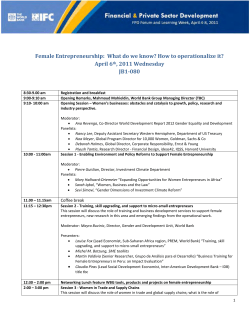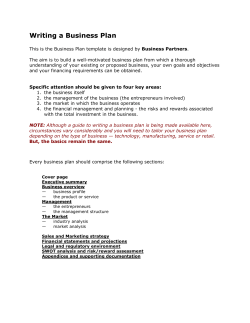
Why Entrepreneurs Don’t Scale by John Hamm Reprint r0212j
Why Entrepreneurs Don’t Scale by John Hamm Reprint r0212j THE ENTREPRENEUR Why Entrepreneurs Don’t Scale by John Hamm The qualities that serve them well in launching businesses often bring them down as their companies grow. I t’s a cliché to say that founders flounder, but unfortunately, that’s usually the case. Wild exceptions like Bill Gates, Steve Jobs, and Michael Dell aside, executives who start a business or project fizzle more often than not once they’ve gotten their venture on its feet. Entrepreneurs actually show their inability to switch to executive mode much earlier in the business development process than most people realize, as my stories will reveal. But the reasons executives fail to “scale” – that is, adapt their leadership capabilities to their growing businesses’ needs–remain fuzzy. It’s simply assumed that there’s an entrepreneurial personality and an executive personality – and never the twain shall meet. I don’t think that’s true. I believe most executives can learn to scale if they’re willing to take a step back and admit to themselves that their old ways no longer work. 2 Over the past four years, I’ve worked closely with more than 100 entrepreneurs and seen them struggle to adapt as their companies grow beyond a handful of employees and launch a new product or service.In the process,I’ve observed that the habits and skills that make entrepreneurs successful can undermine their ability to lead larger organizations. The problem, in other words, is not so much one of leadership personality as of approach. A leader who scales is able to jettison habits and skills that have outlived their usefulness and adapt to new challenges along the way. I’ve identified four tendencies that work for leaders of business units or small companies but become Achilles’ heels for those same individuals when they try to manage larger organizations with diverse needs, departments, priorities, and constituencies. The first tendency is loyalty to comrades – the small band of colleagues Copyright © 2002 by Harvard Business School Publishing Corporation. All rights reserved. there at the start of the enterprise. In entrepreneurial mode, you need to lead like you’re in charge of a combat unit on the wrong side of enemy lines, where it’s all for one and one for all. But blind loyalty can become a liability in managing a large, complex organization. The second tendency, task orientation – or focusing on the job at hand – is critical in driving toward, say, a big product launch, but excessive attention to detail can cause a large organization to lose its way. The third tendency, singlemindedness, is an important attribute in a visionary who wants to unleash a revolutionary product or service on the world. Yet this quality can harden into tunnel vision if the leader can’t become more expansive as the company grows. And the fourth tendency, working in isolation, is fine for the brilliant scientist focused on an ingenious idea. But it’s disastrous for a leader whose burgeoning organization must rely on the kindness of customers, investors, analysts, reporters, and other strangers. Leaders who scale overcome these tendencies by dint of self-discipline, listening to and seeking input from others, and being willing to shift their outlook. They deal honestly with problems and quickly weed out nonperformers. They see past distractions and establish strategic priorities. They make concerted, sometimes uncomfortable efforts to do what doesn’t come naturally to them for the team’s sake. And they learn to work with and communicate to diverse employees, customers, and external constituencies. Most important, they make the company’s continuing health and welfare their top concern. The following stories are about CEOs of technology start-ups, and they’re composites of individuals with whom I’ve worked as an investor, board member, and coach. (The CEOs have all been given pseudonyms here.) Technology start-ups make good case studies because their lack of bureaucracy, compressed product development time, intense relationships, and vulnerability to bottom-line vicissitudes throw leadership challenges into high relief. They yield lessons that apply not only to endecember 2002 trepreneurs as their companies grow but also to project or department leaders as they take on bigger responsibilities in organizations of any size. As we shall see, the ability to effectively lead a project, department, or organization beyond the start-up stage depends on whether or not the executive is hampered by the four hazardous tendencies outlined here. The Scaling Challenge Business school courses can’t really teach students to deal with people objectively, to think strategically, to create loyalty within a diverse workforce, and to impress customers and investors. These capabilities derive from experience that the new CEO may not yet have. No wonder so many entrepreneurs fail to become self-sufficient leaders as their businesses increase in complexity. Without these skills, most new CEOs fall back on what has worked well for them before – even though these old approaches often don’t fit the current problem. A product manager turned CEO may believe the next product will turn a profit. An entrepreneur who cut his teeth in marketing may respond to increasing competition with a new ad campaign. Faced with shrinking revenues, an accountant who’s started a company may focus on reducing costs. But most often, the fledgling CEOs I’ve observed fall into some of the traps outlined below, any one of which can be fatal to a leader’s career, and even to the company being led. These entrepreneurs aren’t aware that by clinging to their existing strengths and habits, they risk creating dysfunctional companies. Let’s examine the four tendencies that can prevent executives from scaling. Loyalty to Comrades. Excessively loyal CEOs may be the best friends you could ever have, but they are the growing organization’s worst enemies. That fault is understandable enough; after all, team allegiance significantly contributes to company success. But when leaders fail to see and respond to a team member’s weaknesses, they place the company at risk. Take Jason, the founder of a company specializing in wireless technology. Jason was enthusiastic and tireless in recruiting his start-up team of 20. As a loyal comrade to the cadre of smart engineers he’d befriended in graduate school and kept in touch with over the years, Jason was able to tap into his old-buddy network to build a highly competent team. Among Jason’s friends was Mark, an engineering professional with whom he had never worked but felt confident would be a brilliant hire. That’s because Mark had previously been a technical development manager for a large enterprise-software company. Jason courted Mark assiduously, enticing him with the opportunity to influence the start-up’s strategy and make a pile of money if the venture was successful. When Mark decided to take the job, Jason was thrilled. At first, Mark seemed like an excellent fit. He was enthusiastic about the technology, and people loved working for him. But as the company prepared to launch its first product, Mark’s team wasn’t equal to the engineering challenge. Accustomed to more development time and a larger staff, Mark was unable to keep up with his job’s demands, and his team failed to meet a critical product milestone. When a board member first raised the subject of Mark’s performance, Jason responded with airy promises: “We’re almost there with the code freeze,” and “We just need another round of tests.” When pressed, Jason made excuses. He insisted that Mark was working very hard, the technology was complex, and the competition was stiff. Jason refused to fire his friend even after competitors beat the company to market with a wireless product that quickly became the industry’s de facto standard. Revenues took a nosedive. Then came the layoffs. Eventually, the investors shut down the company. Such stubborn loyalty, at the expense of an organization’s success, is surprisingly common. But leaders who scale, while not lacking in sympathy toward individuals, understand that the organization’s success depends on every team 3 T H E E N T R E P R E N E U R • W h y E n t re p re n e u r s D o n’ t S ca l e member’s strengths. These leaders understand that their first allegiance must be to a broad community of employees, customers, and investors, and to the fundamentals of the business – not to any single friend. A good example of a leader who didn’t let loyalty stand in the way of smart business is Sandy, the CEO of a small but growing organization that provides DSL broadband service. Like Jason, Sandy was a loyal friend to people she’d known since her career began. She brought in an affable, outgoing college chum, Mike, to run the start-up’s technical sales department. After six months on the job, however, Sandy began to suspect that Mike needed to be more aggressive. Though he had responded to some requests for proposals, he often didn’t follow up. When a promising prospect passed over Sandy’s company in favor of a competitor that had an inferior product, Sandy started asking questions. First, she approached Anne, one of Mike’s sales managers, about his performance. Visibly upset, Anne complained that she’d had to pick up Mike’s slack; 80-hour weeks had taken their toll, and she wasn’t sure how much longer she could keep up the pace. Next, Sandy checked with the CFO, who didn’t deliver any better news about Mike’s performance. If Mike wasn’t able to clinch a deal with a very important prospect, the CFO said, the company would miss a huge revenue opportunity necessary to meet expenses. Sandy decided that Mike had to go, but she wasn’t cold about it. Empathetic and respectful, Sandy made it clear that their partnership just wasn’t working. She acknowledged that Mike had left a great job to join her start-up, but now it was flirting with failure. After laying out the details of the potentially disastrous situation, she said she had no choice but to terminate Mike’s employJohn Hamm is a partner and leadership development coach at Redpoint Ventures in Menlo Park, California. He is the former CEO of Whistle Communications, a technology firm acquired by IBM in 1999. He can be reached at jhamm@redpoint.com. 4 ment, explaining that her decision was nothing personal and she hoped they would remain friends. When Mike left, Sandy became acting head of technical sales until she found a replacement. The company survived. Task Orientation. Executives who focus on the job at hand – particularly those who have done well in operations, product development, or finance – are the weight lifters of the business world. Fledgling CEOs aren’t aware that by clinging to their existing strengths and habits, they risk creating dysfunctional companies. They execute brilliantly with demanding short-term assignments, but longterm strategy is often beyond them. As their companies grow, they often fail to establish strategic priorities. Marvin, an enormously ambitious CEO of a Web services company, was that type of executive. Armed with an advanced degree in computer science, he ran product development for a firm that held a successful IPO during the dot-com era. After cashing in his stock options, Marvin pursued his dream of founding his own company. At the outset, Marvin’s task-oriented style served him well. He hired an impressive core team of engineers and set them to work on one critical task: developing a working prototype for a clearly differentiated product. Marvin’s intense focus on this effort impressed venture capitalists, who rewarded him with a generous first round of financing. As the company put out the product and expanded to 95 people, Marvin’s to-do list grew. His long list of “critical” items included cutting a deal with Dell, hiring a sales VP, getting a big-name CEO on the board of directors, setting a strategy for further technology development, moving into new offices, and launching an intensive public relations and advertising campaign. Marvin del- egated all these tasks to department managers, then rode herd on them. Twice a week, he required managers to update him on their projects’ status. Employees made progress, but Marvin abhorred a vacuum: As soon as they completed one task, he’d fill their lists again. At first, the staff enjoyed being so busy. But within six months, people began to feel overwhelmed. Adding to their frustration was the fact that all final decisions had to pass through Marvin, who refused to make trade-offs. To him, all tasks demanded equal focus. Processes slowed. The marketing plan drifted. No one was more dismayed or surprised than Marvin when a competitor beat his company to market with a new product and inked a significant deal with Dell. And no one was more to blame. In confusing tasks with goals, Marvin had lost control of his company’s direction. The organization muddled along as a third-tier player until a competitor acquired the company at a bargain-basement price. Leaders able to scale, by contrast, understand the importance of a streamlined strategy. They learn to extract three or four high-level goals from a longer list and focus their teams accordingly. And in the face of a new threat or opportunity, they release people from promises that were made at a different point in the development process, allowing them to delay or cancel goals they had committed to when they made sense. Harry, the founder of a small contentmanagement company, understood that a well-developed, simple strategy is the most important pillar of any business. He knew that his company first needed to focus on beating the competition and thus urged employees to concentrate on three activities in service to that goal: consolidating product lines, winning business away from a particularly fierce rival, and focusing on selling to companies with at least 1,000 users. This was Harry’s mantra, and he repeated it at every opportunity, every day, to everyone. That’s not to say Harry’s company left all other important tasks undone. harvard business review W h y E n t re p re n e u r s D o n’ t S ca l e • T H E E N T R E P R E N E U R Rather, Harry let employees set them aside so they could concentrate on the primary goal of beating the competition. For example, when it became clear the sales department had been focusing on customers of various sizes – many small, a few medium, and three large – Harry told the salespeople to forget about small customers. Now, Harry understood that his strategy might be off the mark. After all, he had no crystal ball telling him that the direction he had chosen was the right one. So he availed himself of that rudder on which scalable leaders rely: the quarterly strategy audit. Every three months, Harry gathered the company’s senior managers, directors, advisers, and business colleagues to review current strat- egy. During the four-hour meeting, the group would force itself to distill, from a list of ten, three key initiatives to be accomplished during the next 90 days. The most difficult part of the process was letting go of the remaining seven initiatives on the list. Still, the group emerged having established a simple, yet well-thought-out, plan that every employee could easily understand and follow and that could be altered the subsequent quarter, if need be. As one executive stated, “We might be wrong, but we aren’t confused.” Harry was able to scale because he learned to focus on what was crucial and, in doing so, he could balance competing forces in order to set clear goals for his employees. In many ways, Harry mirrored the approaches of scalable founders-cum-leaders like Dell and Gates, who have been willing to halt extraneous activities and refocus all efforts on a few key accomplishments. Single-Mindedness. We all admire disciplined people, and in start-ups, laserlike focus on the quality and differentiation of a new product or service is an important asset. But a leader’s devotion to a single issue can also damage a growing organization. An insulated leader who doesn’t communicate with and listen to employees with distinct opinions can end up losing their allegiance. Sanjit, the founder of a company specializing in fiber-optic systems, was a serious technologist deeply involved Testing for Scalability If you’re thinking about turning an entrepreneur into a large-company CEO, look before you leap. A prospect can seem stunning on paper or during an interview but can disappoint in practice. The following questions can help reveal what’s beneath the surface. Question: To Determine: To Test for: 1. Have you ever fired someone? Describe what happened. How quickly does the candidate deal with nonperformers? loyalty 2. Pick three priorities from a sample list of ten. Does the candidate think strategically? task orientation 3. Describe a situation in which you were wrong and how you dealt with it. Does the candidate learn from humbling experiences? single-mindedness 4. What do you see as your external role in this position? Is the candidate interested in evangelizing? working in isolation 5. Describe your dream house. Does the candidate have visionary capacity? task orientation 6. What was the scariest moment in your professional career? Is the candidate courageous? single-mindedness 7. If you had to fire either your marketing or engineering VP, whom would you fire first? Does the candidate protect like-minded people? loyalty 8. What would you do if your top salesperson was distracted, and sales were falling apart as a result? Can the candidate separate performance issues from excuses? loyalty 9. What did you like and dislike about your last job? Does the candidate blame others? Is he or she enriched by experience? single-mindedness, loyalty Is the candidate a curious learner? single-mindedness 10. If you could return to school and study something new, what would it be? december 2002 5 T H E E N T R E P R E N E U R • W h y E n t re p re n e u r s D o n’ t S ca l e with the theoretical aspects of his organization’s industry niche. During the start-up stage, Sanjit’s obsession was invaluable: Investors were very impressed with his understanding of and belief in the technology. His passion also appealed to the group of ten like-minded technologists he’d hired to build the company’s breakthrough products. Because they shared his vision, Sanjit didn’t have to spend a lot of time rallying the troops or discussing the company’s strategy. His team members were convinced that when their product entered the market, it would be a runaway hit. Their enthusiasm and energy were palpable. But as the company recruited a more diverse workforce to handle sales and run operations, Sanjit remained absorbed in the technology alone. Indeed, he had no interest in anything aside from fiber optics. He dismissed, ignored, or openly criticized marketers, salespeople, and administrators who failed to appreciate the finer points of the company’s technology. And he ended up with unhappy employees, many of whom arrived not a minute before nine and left at the stroke of five each day. They gossiped about one another and picked interdepartmental quarrels. Marketers blamed technical writers for not providing data-sheet information; tech writers blamed engineers for failing to provide specifications; engineers blamed product managers for dragging their feet with outside partners. Meanwhile, the company failed to attract intelligent contributors or keep the ones it had. Like Marvin’s Web services company, Sanjit’s organization limped along until it was acquired for next to nothing. Sanjit sacrificed employee loyalty to his own single-mindedness. By contrast, executives who scale learn to listen to others and take their opinions into account. They grow with their companies because they realize that their passion is not the only one that matters, and they intentionally broaden their perspective to encompass a range of endeavors. Todd was a CEO who could see beyond his own area of interest. He was an engineer whose start-up developed 6 and marketed software applications for wireless devices. Like Sanjit, Todd was fascinated by the technology and fervently believed that his software concept was not only groundbreaking but also potentially world changing. In response to such enthusiasm, investors wrote him substantial checks. As the company grew, however, Todd realized that it could not live on technological excellence alone. So, unlike Leaders who scale do so because they take deliberate steps to confront their shortcomings and become the leaders their organizations need them to be. Sanjit, Todd paid more attention to issues that didn’t revolve around the technology. He asked the public relations manager, for example, to explain how reporters thought and worked; he encouraged salespeople to describe their customer interactions. Each Friday, Todd held an all-hands meeting outlining progress toward goals and publicly acknowledging the good work of contributors, including administrative assistants and shipping clerks. And in working with his direct reports, Todd stressed the importance of making team members feel valued. By seeking input and information from others, Todd deepened his understanding of their agendas and concerns. Because he encouraged coworkers to take pride in their contributions, they rewarded him with renewed commitment. In the end, his company scored an impressive second round of financing and secured major deals that placed it at the top of its sector. Working in Isolation. An embryonic idea demands protection; in fact, the gestational development itself is excitingly secretive. But after the birth of the product or the idea, the internal focus must shift, lest it impede responsiveness to market demands for the finished product. David, the founder of a software company focusing on e-mail security, was a talented programmer who enjoyed working with his engineering group on developing the first product. An introvert by nature, David liked to work in the cloistered start-up environment, where everyone was devoted to the product. David’s diffidence didn’t bother his few employees. Nor did he feel the need to impress anyone outside his company. Because the organization was small, and because David and his friends and family were the sole investors, he didn’t need to reach out. Then the time came to launch and market the product, and David found all kinds of ways to remain sequestered. As production deadlines loomed, he extended development cutoff dates. He tweaked packaging copy “just one more time.” He canceled meetings with the public relations agency arranging press and analyst meetings. When a reporter called for a prearranged interview, David made sure he was in a meeting. Exasperated, his marketing director finally volunteered to deal with the press in David’s place. As a result of David’s refusal to meet with journalists, the new product was ranked as an also-ran in an important magazine review. Eventually, the board replaced David with someone more comfortable in the evangelist role. Introverted entrepreneurs are often brilliant, but leaders who endure know that success requires some glad-handing and that they have to present their company to the world. Consider Simon, CEO of a small biotech company. A biochemist by training and an introvert by nature, Simon spent his professional career in large corporate research labs before being tapped to head a biotech spinout. His ability to hunker down with his team in the lab helped get the startup’s flagship product off the ground. A year into his tenure, Simon realized that the sales reps were targeting the wrong people in customer organizations. They were selling to midlevel managers, not directors and vice presidents. Sales sagged and the company harvard business review W h y E n t re p re n e u r s D o n’ t S ca l e • T H E E N T R E P R E N E U R was running out of capital as a result. Simon realized that he’d better start meeting with new investors, customers, analysts, and the media before it was too late. Simon forced himself to become a public face for the company. He worked with a media strategist to develop an action plan. He hired a coach who taught him how to appear confident and natural in press interviews. He cold-called both customers and large investment banks. He also contacted top-level salespeople in public companies, persuading two of them to join his team. And when a large customer had to choose december 2002 between his and a competitor’s offerings, Simon stepped in and helped close the sale. Flounder or Fly? Clearly, addressing the problems of loyalty to comrades, task orientation, single-mindedness, and working in isolation during a company’s formative stages will allow the founder to flourish over the long haul. On rare occasions, people rise to the scaling challenge without any special effort. More often, those who scale do so with outside help – say, the feedback of an involved board member, a coach, a mentor, or a facilitator. But entrepreneurs who grow into leaders almost always scale because they are open to learning. They want to be molded by new experiences and to improve their leadership selves. In fact, leaders who scale do so regardless of background, skill, and talent. Rather, they scale because they take deliberate steps to confront their shortcomings and become the leaders their organizations need them to be. Instead of floundering, they learn to fly. Reprint r0212j To place an order, call 1-800-988-0886. 7
© Copyright 2025













